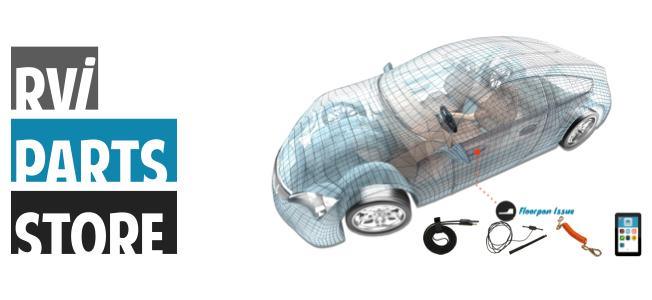Frequently Asked Questions

What is RVibrake?
Q. What is RVibrake System?
A. RVibrake is the smallest, easiest to use, portable auxiliary braking system available. The law requires that a tow vehicle have a braking system when RV towing a car with a Tow Bar or A-Frame system. Unlike other portable braking systems, RVibrake housing pushes against the floor pan (the rise in the floor where the driver’s seat is mounted) instead of the soft seat when activating. This allowed RVibrake to be designed as small as possible making RVibrake easy to install and easy to stow.
Is RVibrake Required?
Q. Why do I need RVibrake?
A. For safety and it is required by law (throughout most of North America).
Safety
Many people are towing a car behind their motorhomes with Tow Bars or A-Frames. A towed vehicle becomes "dead weight" behind a motorhome and will push on the coach as it tries to slow down or stop. In many cases, the towed vehicle can put so much stress on the motor coach's brakes that they may fade or completely fail.
The additional weight of the towed vehicle also greatly increases the distance it takes to stop the motorhome. RVibrake takes the entire weight of the towed vehicle off the motor coach's overburdened brakes. RVibrake greatly reduces your stopping distance by reducing the added weight of the towed vehicle for a safer more secure stop. (See Towing Safety)
Physical Design
Q. Will RVibrake fit in my vehicle?
A. Yes. RVibrake fits in all vehicles. If needed a beautifully engineered custom stop plate will be created for the towed vehicle to ensure proper installation. A custom stop plate is needed in about 5% of all towed vehicles.
Q. Is RVibrake easily transferable between most vehicles?
A. Yes. RVibrake is small, lightweight, and fully adjustable to accommodate the different needs of each towed vehicle. Setup and removal can both be done in about 30 seconds. Q. Is RVibrake a proportional system? A. Yes. RVibrake is the only portable braking system that is truly proportional. RVibrake installs against the floor pan (the rise in the floor where the driver’s seat is mounted) keeping RVibrake stationary. This allows all the of the force of RVibrake to go against the brake pedal. Other braking systems install against seat cushions, which actually absorb force and create movement upon activation.
Installation
Q. How long does it take to setup RVibrake?
A. Setup and removal can both be done in under a minute.
Q. Is there any installation to the motorhome?
A. No. RVibrake is installed in the towed vehicle. The wireless monitor is plugged in to the 12-volt receptacle of the motor home to view and adjust RVibrake settings.
Engineered Design
Q. How does RVibrake know when to brake, since it is not connected to the motorhome?
A. RVibrake is an inertia-activated system designed to detect brakings. This allows RVibrake to take the weight of the towed vehicle off your motorhome every time it activates.
Q. Will RVibrake ride the brakes down steep grades?
A. No. RVibrake applies the brakes in the towed vehicle only when you apply the brakes in the motorcoach. RVibrake's advanced software adjusts for slope, whether you’re going uphill or down. Downshifting or using exhaust brakes will not engage RVibrake.
Q. Will RVibrake wear down my car battery?
A. No. Depending on your towed vehicle's make and model, you may tow for 1-2 days without having to worry about the battery in the towed vehicle. There are two things that can affect your towed battery:
1) If you have a vehicle that requires putting your key in the accessory position with a high amp draw, we make a product called the
Towed Battery Charger that will keep your battery topped off.
2) Life of the battery can also affect performance.
Q. My towed vehicle engine is not running. Will RVibrake still have the power to operate the brakes without vacuum assist?
A. Yes. RVibrake is specifically designed to push with enough force to overcome the absence of vacuum assist.
Q. Since RVibrake is an inertia-activated system, will I get any unwanted braking on bumpy roads?
A. No. RVibrake uses the highest level of technology available. The surge suppressor inside the unit will not engage unnecessarily on bumpy roads, bridges, or railroad tracks.
Q. How does RVibrake interact with my anti-lock braking system (ABS)?
A. When the engine of the towed vehicle is not running, the ABS, which is an electrical feature, is not functioning. If the ignition is on but the engine is off, ABS is active.
Q. What if I only want the RVibrake to perform during panic stops and breakaways?
A. No problem. Just choose the SENSITIVITY setting of LOW. Here's how the sensitivity works:
-
LOW: RVi2 will only perform in a panic stop. In this type of braking you definitely don't have time to look at the monitor.
-
MED: RVi2 will only perform in a hard stop. In this type of braking you probably don't have time to look at the monitor.
-
HIGH: RVi2 will perform 60-70% of the time you put your foot on the brake pedal in the motorhome. The rule of thumb in HIGH is, if you feel your chest getting gently pulled forward in a braking then the RVi2 will brake. The harder you feel your chest getting pulled forward the bigger the graph will grow.
Troubleshooting
Q. How do I know if my towed vehicle's brakes are VACUUM or ACTIVE?
A. Vacuum assist vehicles use vacuum to boost the pressure when braking and Active brake vehicles have constant electrical or hydraulic systems to assist in braking whether the engine is running or not. Most hybrid vehicles use Active assist brakes. Most vehicles on the market use engine vacuum (Vacuum assist brakes) to assist in braking. This means when the engine is off, 2-3 brakings of assist are stored in master booster and must be depleted by the RVibrake2 in setup. To determine what brake type your vehicle has, consult your Manufacturers Owners Guide. (Note: Failure to properly set the vehicle selection to the proper setting may cause severe tire and/or vehicle damage.) If you still have questions or don’t know what type of braking system you have call us at 800-815-2159.
Q. How do I know RVibrake is working?
A. RVibrake's wireless monitor gives you complete, continuous braking information — a glance at the monitor assures you that RVibrake is fully operational. (Note: if the wireless monitor is not plugged in, RVibrake will still continue to work.)
Q. What if I think it’s braking too hard, or not hard enough?
A. Braking force and sensitivity can be modified on the fly from the wireless remote in your motor home. No matter what, RVibrake will always respond with full pressure during an emergency stop.
Q. I have to disconnect my battery for towing. Can I power the RVibrake with the motorhome from my umbilical cord?
A. You never want to power your RVibrake off of the motorhome. The reason is if you have a breakaway, then the RVibrake2 no longer has power. You need it connected to the towed battery. If you have to disconnect your battery for towing or your stock 12V outlet is bad, you'll need to use something like our 12V Direct to Battery Kit.
Q. Why do the tires on my tow vehicle squeal on my first 2-3 brakings of the day?
A. Most vehicles on the market use engine vacuum (Vacuum assist brakes) to assist in braking. This means when the engine is off, 2-3 brakings of vacuum assist are stored in master booster and must be depleted by the RVibrake2 in setup. If you let the engine run during or after installation of the RVibrake, then the master boost will store vacuum assist, causing excessive braking for the first brakings of the day. Always unplug the RVibrake anytime the engine in the tow vehicle is running.






